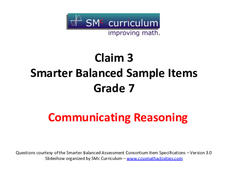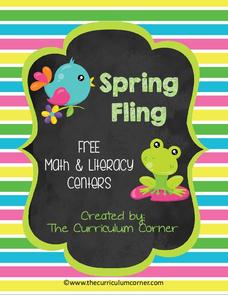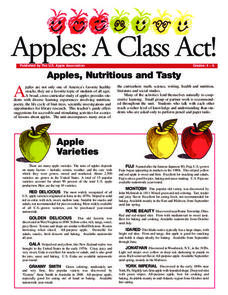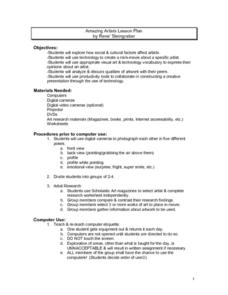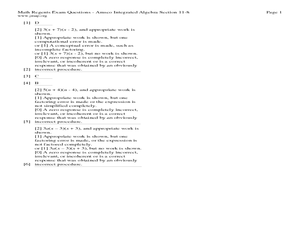Curated OER
Free Enterprise -- Product Cost
Students are introduced to the concept of free enterprise. In groups, they discuss the price of various food items and decide on which item to produce. They calculate the cost of producing the item and share their results with the class.
Curated OER
Environmental Conditions: Friend or Foe
Students research and answer questions on how organisms are classified and how their needs are met through their environment. They work in small groups and create a poster, chart, rap, PowerPoint, or brochure demonstrating how organisms...
Curated OER
Prime Factorizations
In this prime numbers worksheet, students answer multiple choice questions about prime numbers and how they are read. Students answer 10 questions total.
Curated OER
Math Games for Skills and Concepts
A 27-page packet full of math games and activities builds on algebra, measurement, geometry, fractional, and graphing skills. Young mathematicians participate in math games collaboratively, promoting teamwork and skills practice.
Houghton Mifflin Harcourt
Unit 2 Math Vocabulary Cards (Grade 6)
Common denominator, invert, and terminating decimal are only a few terms found in a set of math vocabulary math cards. Made up of 40 cards, the set reinforces terms with boldly printed word cards, and definition cards offering an example...
West Contra Costa Unified School District
Simplifying Fractions
Encourage family participation at home with a reference tool designed to support learners' practice of simplifying fractions. Two pages offer detailed descriptions and labeled examples.
CCSS Math Activities
Smarter Balanced Sample Items: 7th Grade Math – Claim 3
Does the explanation make sense? Sample items highlight claim three, communicating reason, in the Smarter Balanced assessments. Teachers use the 16 items to help show pupils the importance of communication and reasoning within...
Macmillan Education
Time Management
A valuable skills lesson for all grade levels and subject areas, encourage your learners to consider how they are spending their time throughout the day and offer tips for prioritizing and managing daily tasks.
101 Questions
Dandy Candies
Package design is an economic necessity. Young scholars assume the role in an interesting inquiry-based lesson. Given 24 cubic shaped candies to package, they must determine the arrangement that uses the least amount of cardboard to...
Teach Engineering
An Inflated Impression of Mars
Help your class understand the magnitude of the distance between Earth and Mars with an activity that asks small groups to use balloons to create scale models of the Earth, Moon, and Mars. Class members figure out the distances between...
Curriculum Corner
Spring Fling Math and Literacy Centers
Fling your class into spring with a set of math and literacy center worksheets. Learners will enjoy the variety with sheets that practice multiplication, missing addends, before/after and more/less than number comparisons, as well as...
Curated OER
Zero Product Property and Quadratics
In this quadratic worksheet, algebra learners use the zero product property to solve basic quadratic equations. They identify where the parabola crosses the x-axis. Explanations and examples are provided. Answers are located on page two....
Curated OER
Factoring and Solving Quadratics Self-Test
This worksheet provides good practice of factoring expressions and solving quadratic equations by factoring. It also includes a word problem and graphing an equation using a calculator. This one-page worksheet contains 17 polynomial...
Curated OER
How Does News Influence Stock Prices?
Students examine how economic news and business events can change the price of a stock. They see that the unexpected events that benefit or harm the company in turn move the company's stock price up or down.
Soft Schools
Multiplication Table
Use the multiplication table as an aid for young mathematicians who are learning their multiplication facts. Children can explore the concept of multiplication by using the factors in the far left column and the top row to determine a...
US Apple Association
Apples: A Class Act! (Grades 4–6)
Middle schoolers have a bushel of fun as they engage in activities and research core facts about apples. Packed with suggestions for in-class activities and out-of-class research, the colorful 6-page packet is sure to satisfy hungry...
Curated OER
Amazing Artists
High schoolers examine how social and cultural factors affect artists. In small groups they select a specific artist, and conduct research. Students then use a digital camera and digital video camera to create a mini-movie about their...
Curated OER
Those Golden Jeans
Students review the productives resources used to produce goods and services and explore how decisions are made in a market economy through the interactions of both the buyers and the sellers.
Curated OER
Study Buddies- Estimating Products
In this math worksheet, students work with a partner to practice estimating products using rounding. They discuss the process of rounding and whether multiplying the rounded numbers is easier or more difficult than multiplying the...
Curated OER
Climate Change
Students focus on the production of maple syrup in Northern New England as they study the effects of climate change. They investigate other environmental factors on the forests of Northern New England.
Curated OER
Factoring
Ninth graders factor equations and find prime numbers. In this algebra lesson, 9th graders find the factors and prime factors of a number using multiples and relatively prime numbers.
Curated OER
Factoring a Polynomial Completely
In this Algebra I/Algebra II worksheet, students factor a polynomial completely. The one page worksheet contains a combination of six multiple choice and free response questions. The answers are included.
Curated OER
Multiplying With 7, 8 9 (E)
In this finding the product worksheet, students multiply factors seven, eight, and nine times factors ranging from one to twelve. Students solve 100 problems.
Curated OER
Multiplying With 7, 8, 9 (F)
In this finding the product worksheet, students multiply factors seven, eight, and nine times factors ranging from one to twelve. Students solve 100 problems.








